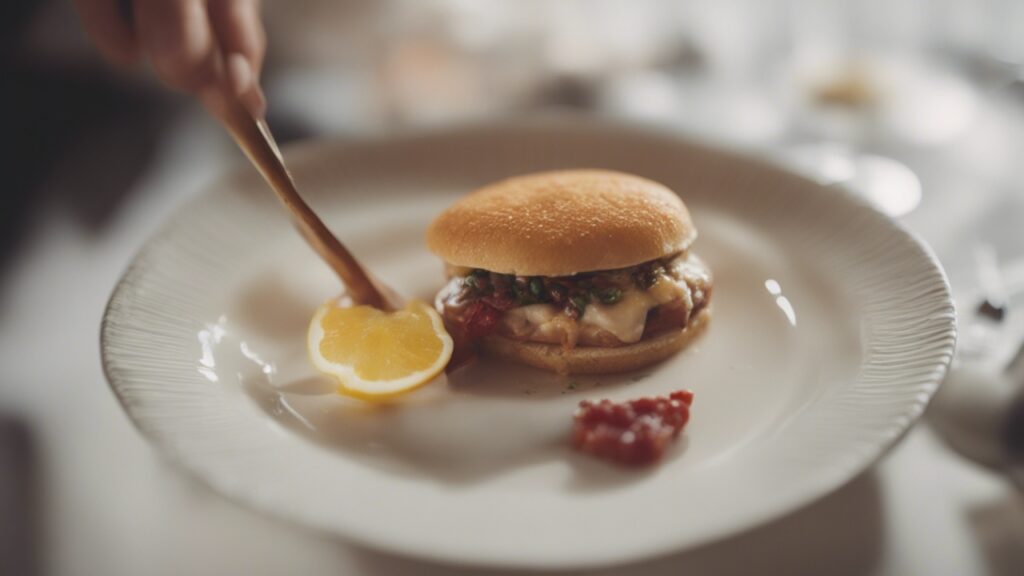

A recipe provides detailed instructions for preparing a specific dish, while a menu lists available food and beverage options. A recipe includes ingredients and steps, while a menu showcases a selection of items.
Exploring the culinary world requires understanding its basic elements: recipes and menus.
Recipes serve as a roadmap, guiding cooks through creating a delightful dish. They break down ingredient measurements, preparation methods, cooking times, and serving suggestions.
Conversely, menus are like catalogs of culinary creations offered by a restaurant or prepared for a specific event.
They present diners with various choices, often categorized by course or mealtime.
Both tools are essential in the dining experience, whether whipping up a homemade meal or selecting from a chef’s repertoire in a dining establishment.
They cater to the needs of individuals crafting a meal and those seeking to indulge in one.
Breaking Down the Basics


Are you curious about the building blocks of culinary delights? Understanding the difference between a recipe and a menu is essential.
Let’s nibble on the essentials better to appreciate the art of cooking and meal planning. Both recipes and menus have unique roles in culinary experiences.
It’s time to digest this delicious knowledge and become a kitchen whiz!
Defining a Recipe
At its heart, a recipe is a roadmap for cooking. It includes a list of ingredients, precise quantities, and detailed instructions.
A recipe guides cooks to create a specific dish and ensures consistency and flavor each time.
Think of a recipe as a formula—it’s the secret to making your favorite meals repeatedly.
- Ingredients: What you need.
- Quantities: How much to use.
- Instructions: Steps to create the dish.
Recipes can be simple or complex. They might include tips, serving suggestions, or variations.
These are tools for anyone to reproduce a dish, no matter their experience level.
Understanding a Menu
A menu plays a different role. Think of a menu as a showcase or a catalog. It lists various dishes available for selection, typically in a dining establishment.
Menus enable choice. They organize offerings into appetizers, main courses, and desserts.
Every restaurant has its menu tailored to its cuisine, theme, and culinary philosophy.
- Appetizers: Starters to whet the appetite.
- Main Courses: Heartier, full dishes.
- Desserts: Sweet finishes to a meal.
Menus also detail the ingredients and may highlight if a dish is spicy, gluten-free, or suitable for vegetarians.
They are the guests’ guide to making a meal decision. The menu is your starting point for meal selection, whether at a fast-food joint or a fine-dining restaurant.
The detailed recipe guide and the curated menu list play crucial roles in the culinary world.
As you can see, recipes are the blueprint for individual dishes, while menus compile these dishes for an enjoyable dining experience.
Together, they create the harmony of a satisfying meal, from kitchen to table.
Ingredients vs. Selections
Two major concepts often come to mind when thinking about food: recipes and menus. Each plays a unique role in the world of culinary arts.
Understanding the difference hinges on ingredients versus selections. Let’s dive into the role ingredients play in recipes and how menus offer a variety of choices.
The Role of Ingredients in Recipes
Every dish begins with a blueprint, a recipe. Recipes list the necessary ingredients and steps to create a meal.
Ingredients are the building blocks of any recipe, each adding a distinct flavor, texture, and aroma. The success of a dish relies on these elements.
Here’s how ingredients come together:
- Flavors merge to create a specific taste.
- Measurements ensure the balance of these flavors.
- Quality of ingredients can elevate a simple dish to a remarkable one.
Combining ingredients in just the right way makes each recipe unique. Think of it as a formula that, when followed, produces a consistent and delicious result every time.
The Variety of Choices in a Menu
A menu is a different beast altogether. A menu is like a showcase, presenting a collection of prepared dishes you can choose from. Here’s what menus offer:
- A wide selection of appetizers, mains, desserts, and drinks.
- Options for different preferences, including vegetarian, gluten-free, and spicy.
- Descriptive item names and details that entice diners.
A menu’s versatility lies in its variety. It’s a curated list that often reflects a chef’s skills or a restaurant’s theme.
It tempts patrons with a selection where each item has been perfected through its recipe.
Function and Purpose
Understanding the function and purpose of recipes and menus is vital in the culinary world.
Recipes guide us in creating dishes, while menus showcase these creations enticingly. Let’s dive into how each serves its unique role in the culinary experience.
Recipes as Instruction Manuals
Think of a recipe as a blueprint for building a delicious dish. It’s a step-by-step guide anyone can follow to recreate a specific meal.
Each recipe provides the necessary components:
- Ingredients list – the building blocks of the dish.
- Quantities – exact measurements for precision.
- Instructions – a sequence to follow for best results.
- Cooking times and temperatures – to ensure perfection.
Recipes are essential for learning and master cooks and bakers.
Menus as Catalogs of Cuisine
Menus, on the other hand, are the showcase of a restaurant’s offerings. They serve a different purpose:
- Selection overview – all the dishes and drinks available.
- Organized categories – such as appetizers, main courses, and desserts.
- Description of dishes – helps diners imagine the taste and presentation.
- Price information – so guests can make informed choices.
Menus entice diners and reflect a restaurant’s identity. They are the invitation to a culinary journey.
Culinary Contexts
When entering the world of culinary arts, understanding the distinction between a recipe and a menu is as essential to a chef as a knife is to a chef.
These terms often get tossed around together, yet they serve distinct roles. Recipes are the blueprints for creating individual dishes, while menus are a collection of these dishes presented to the diner.
Let’s delve deeper into their unique places in the culinary universe.
Recipes in the Kitchen
Recipes act as a guide for cooking. They offer step-by-step instructions to achieve a delicious outcome.
Consider the following points about recipes:
- Ingredients are listed with exact quantities.
- Method is provided, detailing how to combine these ingredients.
- Recipes can include tips and tricks, enhancing the dish’s flavor or presentation.
- Experience levels may vary—some recipes suit beginners; others challenge experts.
A recipe is your roadmap in the culinary landscape, moving you from raw ingredients to a completed dish.
Menus in the Dining Experience
Menus create a narrative for your meal. They highlight a selection of dishes crafted from various recipes.
Here’s what makes menus special in the dining experience:
Menus presents options for appetizers, entrées, and desserts.
They often reflect the chef’s expertise and the restaurant’s concept.
| Type of Menu | Features |
|---|---|
| À la carte | Independent choice of dishes |
| Set Menu | Fixed series of courses |
| Seasonal Menu | Reflects current season’s ingredients |
Ultimately, a menu is a way to showcase culinary creations and entice diners into the meal’s journey.
Design and Layout Considerations
Design and Layout Considerations are crucial in perceiving and understanding recipes and menus.
Whether you’re flipping through a cookbook or scanning a restaurant menu, the organization, visual appeal, and readability directly influence your experience.
This section explores how presentation affects recipes and menus.
Recipe Formats and Styles:
Recipes require a clear and concise format to guide anyone through cooking. Key elements typically include:
- Title – The name of the dish.
- Ingredients – A detailed list, often in the order of use.
- Instructions – Step-by-step preparation and cooking guidelines.
- Tips – Suggestions for best results.
Practical recipes may also contain:
- Nutritional information.
- Serving size.
- Preparation and cooking time.
- Photos or illustrations.
Formats vary, from classic numbered lists to modern, infographic-style presentations. The goal is always clarity and ease of use.
Menu Presentation and Design:
In contrast, a menu’s role is to entice and inform diners. Key design considerations include:
| Aspect | Importance |
|---|---|
| Layout | Organizes items for easy navigation. |
| Typography | Ensures readability and sets the tone. |
| Color Scheme | Aligns with the restaurant’s theme. |
| Images | Showcase dishes and stimulate appetite. |
A well-designed menu tells a story about the food and the dining experience.
It merges functional organization with creative elements to capture a diner’s interest and convey the restaurant’s brand.
Whether elegant and minimalist or bold and vibrant, the design choices set the stage for the coming meal.
Cultural and Historical Perspectives
Exploring culinary arts involves a rich tapestry of cultural and historical influences.
The relationship between recipes and menus runs deep into the annals of food history, illustrating human creativity and societal evolution.
These elements offer insightful stories about who we were, who we are, and potentially, who we will become.
Evolution of Recipes Through Time
Recipes have journeyed from oral traditions to written testimonials of human civilization.
They serve as time capsules, capturing flavors and cooking methods across various periods.
- Ancient texts etch the earliest recipes on clay tablets.
- Medieval cookbooks reflect regal tastes and feast preparations.
- Industrial-age printings make recipes widely available.
- The modern digital age transforms recipes into online, shareable formats.
Menu Development and Trends
Menus narrates the story of dining habits over time.
They are living documents that adapt to culinary trends, economic factors, and societal changes.
| Period | Key Trend |
|---|---|
| 18th Century | Introduction of à la carte |
| 19th Century | Grand menus for aristocracy |
| 20th Century | Fast food and ethnic cuisine rise |
| 21st Century | Focus on sustainability and farm-to-table |
The ongoing trend includes the fusion of global cuisines, an emphasis on authentic experiences, and personalized dietary menus.
Frequently Asked Questions
What is the Difference Between a Menu and a Recipe?
A menu lists available food and drink options at a restaurant. A recipe provides instructions for preparing a specific dish, including ingredients and cooking steps.
What’s the Difference Between Recipes and Ingredients?
A recipe is a set of instructions to prepare a dish, while ingredients are the raw materials used to make the dish.
What is a Menu Considered?
A menu is a list of food and beverage offerings available at a restaurant or event.
What is the Difference Between a Menu and a Meal Plan?
A menu outlines food options offered by a restaurant, while a meal plan is a schedule of dishes for personal dietary goals.
Menus present single meal choices; meal plans organize multiple meals over a period.
What Defines a Recipe in Cooking?
A recipe is a set of instructions for preparing a particular dish, including a list of ingredients and steps.
Conclusion
Understanding the distinction between a recipe and a menu enhances your culinary know-how.
Recipes are blueprints for creating individual dishes, while menus present a curated selection.
Both are pillars in the art of dining, guiding cooks and diners toward a satisfying meal experience.
Embrace the nuances of each to elevate your next kitchen venture or dining adventure.







